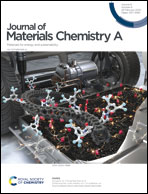Electric field-based ionic control of selective separation layers†
Abstract
The application of membrane technology to separate and extract target ions, such as lithium or chlorine, has recently seen considerable growth as a research topic, driven by the growing demand for energy and the environmentally friendly status of this technology. Based on the alternating current electric field layer-by-layer assembly technology, we report in this work target ionic control membrane surface multilayers with ion channels and ion exchange sites to control selective ion separation in electrodialysis. The reported surface multilayers utilize ion interactions between electric field force and charged groups and the mechanics of the target ion controlling the construction of ion exchange sites in an oppositely charged polymer layer and target ion channels in a like-charged monomer layer. The resulting membranes act as a strong barrier for multivalent ions, displaying a selective separation efficiency parameter equal to 99.99% for PO43−/Cl− and 99.99% for SO42−/Cl− in the resulting anion exchange membrane, and 83.70% for Mg2+/Li+ and 64.51% for Ca2+/Li+ in the resulting cation exchange membrane. Contrary to the initial selective separation efficiency between monovalent ions (−16.50% for Br−/Cl− and −40.00% for K+/Li+), the resulting membranes remarkably enhanced the transport of the target ions more easily than for other monovalent ions (0.76% for Br−/Cl− and −9.10% for K+/Li+). This work suggests promising new quantum mechanics of ion and electric field-based ionic control concepts to synthesize membranes with the ability to selectively separate a target ion.



 Please wait while we load your content...
Please wait while we load your content...